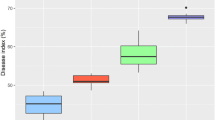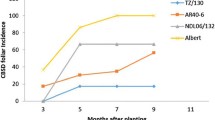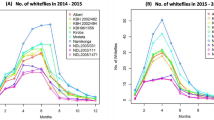Abstract
Thirty-five cassava (Manihot esculenta Crantz) genotypes from the International Institute of Tropical Agriculture (IITA), germplasm collection were planted in May 1992 under natural disease infection conditions, at the IITA field plots at Ibadan, Nigeria. The genotypes were evaluated at monthly intervals for six months, for incidence and severity of cassava anthracnose disease (CAD), cassava bacterial blight (CBB) and African cassava mosaic virus (ACMV). The effect of the pathogens on yield was also evaluated twelve months after planting (MAP). CAD, CBB and ACMV incidence and severity were significantly different (P<0.05) among the cassava genotypes at 3 and 6 months after planting. ACMV incidence and severity reached the maximum levels at 3 MAP while CAD and CBB had a low incidence and severity at that period but exhibited a high disease symptom expression at 6 MAP. Yield parameters (plant stand, tuber number, tuber weight and tuber dry matter) differed significantly (P<0.05) between the cassava genotypes. ACMV and CBB severity was negatively correlated with tuber number (r = −0.54 and r = −0.62 respectively). CAD severity was negatively correlated with tuber number (r = −0.46) and tuber weight (r = −0.63). Percentage dry matter was significantly correlated with ACMV severity (r = 0.71), CBB severity (r = 0.63) and CAD severity (r = 0.42). There was also a significant correlation between CBB and ACMD severity (r=0.46) and CBB and CAD severity (r=0.62). Tuber number and yield were significantly correlated (r=0.60), while% dry matter content and root rot showed a significant negative correlation (−0.42).
Similar content being viewed by others
References
Asiedu, R., K.V. Bai, R. Terauchi, A.G.O. Dixon & S.K. Hahn, 1992. Biotechnology: Enhancing Research on Tropical Crops in Africa. In: Thottappilly, G., L.M. Monti & A.W. Moore (Eds), IITA/CTA publication, pp. 63-68.
Bock, K.R. & R.D. Woods, 1983. Etiology of African cassava mosaic disease. Plant Disease 76: 994–995.
Boher, B., J.F. Danielle & G. Bani, 1983. Action de Pseudotheraptus devastans (Dist) et de Colletotrichum gloeosporioides Penz, dans le dévélopement des chancre et la chutte de feuilles chez le manioc. Agronomie 3: 989–994.
Food and Agriculture Organization (FAO), 1993. FAO Food production statistics FAO. Rome, Italy, 31 pp.
Friend, J., 1981. Plant phenolics, lignification and diseases. Progr. Phytochem. 7: 197–261.
Goodman, R.N & A.J. Novacky, 1994. The hypersensitive reaction in plant pathogens: A resistance phenomenon. APS Press, St. Paul, MN, pp. 3–35.
Hahn, S.K., E.R. Terry & K. Leuschner, 1980. Breeding cassava for resistance to cassava mosaic disease. Euphytica 29: 673–683.
Hahn, S.K., J.C. Isoba & T. Ikotun, 1989. Resistance breeding in root and tuber crops at the International Institute of Tropical Agriculture, Ibadan, Nigeria. Crop Protection 35: 147–168.
Hahn, S.K., K.U. Bai & R. Asiedu, 1990. Tetraploids, triploids and 2n pollen from diploid interspecific crosses with cassava. Theor. Appl. Genet. 79: 433–439.
Msabaha, M.M., 1981. Genetic relationship between resistance to Mosaic and bacterial blight in cassava (Manihot esculenta. Crantz). Ph.D. Thesis, Dept. of Agric. Biology. University of Ibadan, Ibadan, Nigeria. 241 pp.
International Institute of Tropical Agriculture (IITA), 1987. Integrated Pest Management for Tropical Root and Tuber Crops. In: Hahn, S.K. & F.E. Caveness, (Eds), Proceedings of the Workshop on the global Status and Prospects for Integrated Pest Management (IPM), Oct. 25-30, Ibadan, Nigeria. 235 pp.
International Institute of Tropical Agriculture (IITA), 1990. Cassava in Tropical Africa. A reference manual, IITA, Ibadan, Nigeria. 108 pp.
Ikotun, T., 1981. Some characteristics that distinguish Xanthomonas manihotis from Xanthomonas cassavae. Fitopatologia Brasileira 6: 15–21.
Jalloh, A. & M.T. Dahniga, 1994. Productivity of cassava under different land preparation methods on the Upland in Sierra Leone. Root Crops for food security in Africa. In: Akoroda, M. (Ed.), Proc. 5th Triennial Symposium of the International Society of Tropical Root Crop (ISTRC), Africa branch, Kampala, Uganda, 22-25 Nov. 1992. 452 pp.
Jennings, D.L. & C.H. Hershey, 1985. Cassava breeding: A decade of progress from International Programmes. In: Russell, G.E. (Ed.), Progress in Plant Breeding (Vol 1) Butterworth, London, UK, pp. 89–116.
Lozano, J.C., 1986. Cassava bacterial blight: a manageable disease. Plant Disease 70: 1089–1093.
Lozano, J.C., A.C. Bellotti, J.A. Reyes, R.H. Howland, D. Leihner & J. Dol, 1981. Field problems in cassava. Centro Internacional de Agricultura Tropical, Cali, Colombia. 205 pp.
Muimba, K.A., 1982. Predisposition of cassava plants to infection by Colletotrichum manihotis Henn, and some factors involved in the initiation of anthracnose disease. M.Phil. Thesis, University of Ibadan, Nigeria. 241 pp.
Muyolo, G., 1984. Studies on the interaction between Xanthomonas campestris pv. manihotis Berthet and Bondar and Colletotrichum gloeosporioides f. sp. manihotis Chev, on cassava and its effects on yield. M.Phil. Thesis, Dept of Agric. Biology, University of Ibadan, Nigeria. 255 pp.
Roger, C., 1990. Principes de phytopathologie et de lutte contre les maladies des plantes. Presse Polytechniques et Universitaires Romandes, pp. 107-123.
Rossel, H.W., G. Thottappilly, J.M.W. Van Lent & H. Huttinga, 1987. The etiology of cassava mosaic disease in Nigeria. Paper presented at the International conference on African cassava mosaic disease and its control, 4-8 May 1987, Yamoussoukro, Côte d'Ivoire. 15 pp.
SAS Institute, 1989. SAS user's guide: Statistics, version 5. SAS Inc., Cary, NC. 231 pp.
Theberge, R.L., 1985. Common African pests and diseases of cassava, yam, sweet potato and cocoyam. International Institute of Tropical Agriculture, Ibadan, Nigeria. 107 pp.
Thomas, J.G., P.R. Massaiski & B.D. Harrison, 1987. Production of monoclonal antibodies to African cassava mosaic virus and differences in their reactivities with other white-fly transmitted geminiviruses. J. Gen. Virol. 67: 2739–2748.
Van der Bruggen, P. & H. Maraite, 1987. Histopathology of cassava anthracnose disease caused by Colletotrichun gloeosporiodes f.sp. manihotis. J. Phytopathol. 130: 46–58.
Whyte, J.B.A., 1987. Breeding cassava for adaptation to environmental stress. In: Hershey, C.H. (Ed.), Cassava Breeding: A Multidisciplinary Review. Proceedings of a Workshop held in the Philippines, 4-7 March 1985. CIAT, Cali, Colombia. pp 147–176.
Author information
Authors and Affiliations
Rights and permissions
About this article
Cite this article
Fokunang, C.N., Akem, C., Dixon, A. et al. Evaluation of a cassava germplasm collection for reaction to three major diseases and the effect on yield. Genetic Resources and Crop Evolution 47, 63–71 (2000). https://doi.org/10.1023/A:1008797225343
Issue Date:
DOI: https://doi.org/10.1023/A:1008797225343




